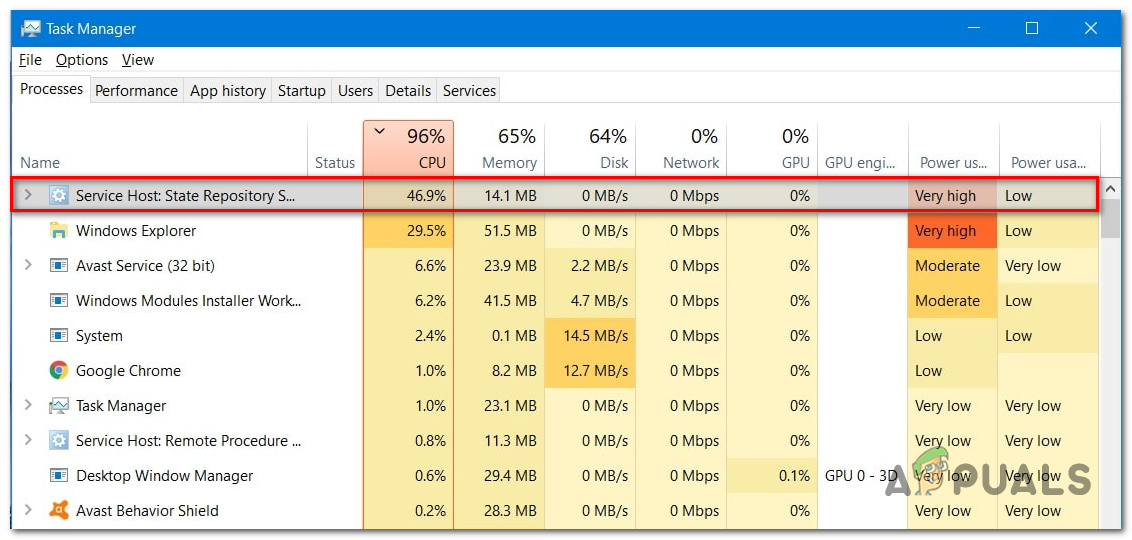If the issue is being caused by a common glitch, the issue can be resolved easily simply by restarting the repository service. However, if you’re encountering this issue along with frequent error entries in Event Viewer, you should be able to fix the issue by cleaning the component store or by performing a clean install or in-place repair. But as it turns out, most instances of this problem are actually triggered by Microsoft Edge in one way or another. To resolve this issue in this case, you’ll need to repair Microsoft Edge from the Apps & Features menu. If that doesn’t work, you should consider reinstalling every built-in UWP app. There’s also the option of disabling the State Repository service altogether in order to stop the high CPU usage, but this will affect the functionality of Microsoft Edge.
How to fix the High CPU usage caused by the State Repository Service?
Method 1: Restart the State Repository Service
Before trying out more complex fixes, you should start by seeing if the issue is not being caused by a simple glitch that affects the State Repository Service on Windows 10. If you’re looking for a temporary fix that will reduce the CPU usage immediately, you should try restarting the state repository service. A lot of affected users have confirmed that this operation has managed to bring the resource usage down considerably (at least until the next system startup). Although this fix won’t fix the issue indefinitely, it’s still the preferred approach if you’re looking for something quick and non-intrusive that will stop the general stuttering from occurring. In case the CPU usage of the State Repository service returns to high value or you’re looking for a more permanent fix, move down to the potential next fix below.
Method 2: Cleaning up the component store
If you’re frequently seeing high CPU usage caused by the State Repository Service and you’ve also discovered a lot of different errors pointing towards the same service inside the Event Viewer, chances are the problem is being caused by a corrupted component store. When it comes to this particular scenario, the issue can be resolved swiftly by using the DISM (Deployment Image Servicing and Management) to replace corrupted instances with healthy copies. Note: Before starting with this method, keep in mind that DISM is heavily reliant on Windows Update to download healthy copies that will be used to replace corrupted data. Because of this, you’ll need to ensure that your Internet connection is stable before initiating this procedure. In what follows, we will initiate a component cleanup from an admin terminal using DISM and then finishing it up with an SFC (System File Checker scan). Note: It’s important to follow the steps below in the same order in order to get the issue resolved. In case you’re still noticing high CPU usage associated with the State Repository Service and frequent errors in Event Viewer, move down to the next potential fix below.
Method 3: Repairing Microsoft Edge
As it turns out, Microsoft Edge is a built-up application with the potential of abusing the State Repository Service. Under certain circumstances (especially when 3rd party extensions are installed), Microsoft Edge has the potential of becoming a huge CPU hogger, to the point where it slows the whole system down. Several affected users that faced the same problem have confirmed that they finally managed to resolve the issue by going to the Apps and Features menu and resetting Microsoft Edge from the Advanced options menu. This operation will end up removing any temp or 3rd party data that might be responsible for the high CPU usage of the State Repository service. Here’s a quick guide on resetting the Microsoft Edge from the Apps and Features: In case the same problem is still occurring, move down to the next potential fix below.
Method 4: Reinstalling every Built-in app
If you’re encountering the issue on a Windows 10 build raging between v1703 and v1709, chances are the problem is facilitated by an inconsistency has to do with the fleet of built-in apps that Windows 10 has by default. Several affected users have confirmed that they managed to fix the issue by reinstalling every built-in app with a single Powershell command. This operation will end up reinstalling and re-registering every built-in app, which takes care of every glitched UWP app instance that might contribute to the high CPU usage of the State Repository service. Here’s a quick guide on reinstalling every built-in app using powershell: In case the same problem is still affecting your machine, move down to the next potential fix below.
Method 5: Disabling the State Repository Service
Keep in mind that by default, the State Repository service improves on the functionality of Microsoft Edge by acting as a browser cookie. It works by regularly taking a snapshot of the browsing information – this helps Microsoft Edge to continue where it left off (even across multiple devices). If you have no use of this service (e.g. you don’t use Edge), one way to ensure that the State Repository service is no longer taking a lot of your CPU resources is by preventing it from starting at every system startup. This operation can be achieved by using MSConfiag to disable the startup key associated with the State Repository Service. Here’s a quick guide on how to do this: Note: The steps below can be followed on every Windows version, not just Windows 10. In case you’re still encountering the same high CPU usage caused by the State Repository service, move down to the next potential fix below.
Method 6: Performing a clean install or in-place repair
If you followed all the potential fixes above and none of them have helped you to reduce the CPU usage of the State Repository service, it’s clear that you’re encountering the issue due to some type of system corruption that cannot be fixed with the regular channels. If you’ve come this far without a result, the only recommended fix we have left for you is to reset every Windows component (and boot related data) in order to ensure that no corrupted system file is creating the issue. When it comes to resetting every involved Windows component, there are two ways forward:
Clean Install – This potential fix is the most convenable out of the bunch. You don’t need a compatible installation media and the fix can be deployed directly from the GUI menu of Windows 10. However, without backing up your data in advance, expect partial data loss (including apps, games and personal media stored on the OS drive)Repair Install – A repair install is the most focused approach, allowing you to reset your computer without any data loss (even your games, applications and user preferences will remain intact). However, you will need a compatible installation media in order to deploy this repair strategy.
[FIX] Service Host: Diagnostic Policy Service High CPU & Memory UsageFix: Deferred Procedure Calls and Interrupts Service Routines High CPU and Disk…Fix: High Disk or CPU Usage “Service Host Delivery Optimization"How to Fix Unistack Service Group (unistacksvcgroup) High CPU or Memory Usage







